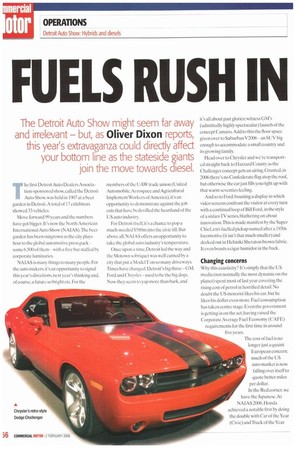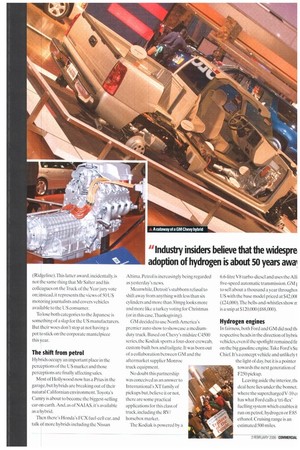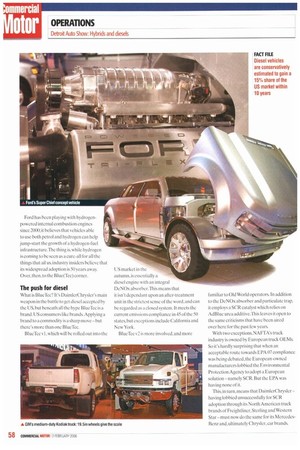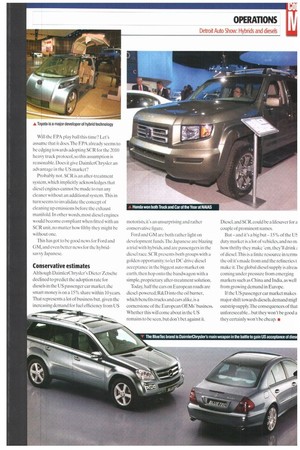FUELS RUSH IN
Page 56

Page 57

Page 58

Page 59

If you've noticed an error in this article please click here to report it so we can fix it.
The Detroit Auto Show might seem far away and irrelevant — but, as Oliver Dixon reports, this year's extravaganza could directly affect your bottom line as the stateside giants join the move towards diesel.
The first Detroit Auto Dealers Associalion-sponsored show, called the Detroit Auto Show was held in 1907 at a beer garden in Detroit.A total of 17 exhibitors showed 33 vehicles.
Move forward 99 years and the numbers have got bigger. It's now the North American International Auto Show (NAIAS).The beer garden has been outgrown as the city plays host to the global automotive press pack— some 6.500 of them with a free bar staffed by corporate luminaries.
NAIAS is many things to many people. For the auto makers, it's an opportunity to signal this year's directions, next year's thinking and, of course.a future so bright etc. For the members of the UAW trade union (United Automobile.Aerospace and Agricultural Implement Workers of America), it's an opportunity to demonstrate against the job cuts that have bedevilled the heartland of the US auto industry.
For Detroit itself, it's a chance to pop a much-needed $58Orn into the civic till. But above all, NA I AS offers an opportunity to take the global auto industry's temperature.
Once upon a time. Detroit led the way and the Motown sobriquet was well earned by a city that put a Model T on so many driveways. Times have changed. Detroit's big three —GM, Ford and Chrysler — used to be the big dogs. Now they seem to yap more than bark, and it's all about past glories; witness GM's (admittedly highly spectacular) launch of the concept Camaro. Add to this the floor space given over to Suburban V2006 —an SIN big enough to accommodate a small country and its growing family.
Head over to Chrysler and we're transported straight back to Hazzard County as the Challenger concept gets an airing. Granted, in 2006 there's no Confederate flag atop the roof, but otherwise the car just fills you right up with that warm seventies feeling.
And so to Ford. boasting a display in which video screens confront the visitor at every turn with a continual loop of Bill Ford, jothe style of a sixtiesTV series. blathering on about innovation.This is made manifest by the Super Chief, a tri-fuelled pickup named after a 1930s locomotive (it isn't that much smaller) and decked out in Helsinki Sheraton brown fabric. It even boasts a cigar humidor in the back.
Changing concerns
Why this causticity? It's simply that the US media (not normally the most dynamic on the planet) spent most of last year covering the rising cost of petrol in horrified detail. No doubt the US motorist likes his car, but he likes his dollar even more. Fuel consumption has taken centre stage. Even the government is getting in on the act, having raised the Corporate Average Fuel Economy (CAFE) requirements for the first time in around five years.
The cost of fuel is no longer just a quaint European concern; much of the US auto market is now falling over itself to quote better miles per dollar.
In the Red corner. we have the Japanese.At NA [AS 2006. Honda achieved a notable first by doing the double with Car of the Year (Civic) andTruck of the Year (Ridgeline ).This latter award, incidentally, is not the same thing that Mr Salter and his colleagues on the Truck of the Year jury vote on; instead,it represents the views of SOUS motoring journalists and covers vehicles available to the US consumer.
To lose both categories to the Japanese is something of a slap for the I. JS manufacturers. But their woes don't stop at not having a pot to stick on the corporate mantelpiece this year.
The shift from petrol
Hybrids occupy an important place in the perceptions of the US market and those perceptions are finally affecting sales.
Most of Hollywood now has a Prius in the garage, but hybrids are breaking out of their natural Californian environment. Toyota's Carrtry is about to become the biggest-selling car on earth. And, as of NAIAS, its available as a hybrid.
Then there's Honda's FCX fuel-cell car, and talk f more hybrids including the Nissan Altima. Petrol is increasingly being regarded as yesterday's news.
Meanwhile. Detroit's stubborn refusal to shift away from anything with less than six cylinders and more than 30mpg looks more and more like a turkey voting for Christmas (or in this case,Thanksgiving).
GM decided to use North America's premier auto show to showcase a mediumduty truck. Based on Chevy's midsize C4500 series, the Kodiak sports a four-door crewcab, custom-built box and tailgate. It was born out of a collaboration between GM and the aftermarket supplier Monroe truck equipment.
No doubt this partnership was conceived as an answer to International's XT family of pickups but, believe it or not. there are some practical applications for this class of truck, including the RV/ horsebox market.
The Kodiak is powered by a
6.6-litre VS turbo-diesel and uses the AN five-speed automatic transmission. GM to sell about a thousand a year throughot US with the base model priced at 542,00( (£24,((X)).The bells-and-whistles show nis a snip at S120.000 (£68,(X0).
Hydrogen engines
In fairness, both Ford and GM did nod thi respective heads in the direction of hybri( vehicles, even if the spotlight remained fir on the big gasoline engine.Take Ford's Su Chief. It's a concept vehicle and unlikely t the light of day, but it is a pointer towards the next generation of F250 pickup.
Leaving aside the interior, thi deal here lies under the bonnet, where the supercharged V-10 ei has what Ford calls etri-flex' fuelling system which enables it run on petrol, hydrogen or E85 ethanol. Cruising range is an estimated 500 miles. Ford has been playing with hydrogenpowered internal combustion engines since 2000:it believes that vehicles able to use both petrol and hydrogen can help jump-start the growth of a hydrogen-fuel infrastructure.The thing is. while hydrogen is coming to he seen as a cure-all for all the things that ail us. industry insiders believe that its widespread adoption is 50 years away. Oyer, then. to the Blue(Tee) corner.
The push for diesel
What is Blue'lec? It's DaimlerChrysler's main weapon in the battle to get diesel accepted by the US, hut beneath all the hype BlueTee is a brand. US consumers like brands. Applying a brand to a commodity is a sharp move but there's more than one BlueTec.
BlueTec vi. which will be rolled out into the US market in the autumn. is essentially a diesel engine with an integral DeNOx absorber.This means that it isn't dependant upon an after-treatment unit in the strictest sense of the word. and can be regarded as a closed system. It meets the current emissions compliance in 45 of the 50 states, hut exceptions include California and New York.
BlucTec v2 is more involved, and more familiar to Old World operators. In addition to the DeN0x absorber and particulate trap. it employs a SCR catalyst which relies on AdBlue urea additive.This leaves it open to the same criticisms that have been aired over here for the past few years.
With two exceptions. NAFTA's truck industry is owned by European truck OEMs. So it's hardly surprising that when an acceptable route towards EPA 07 compliance was being debated.the European-owned manufacturers lobbied the Environmental Protection Agency to adopt a European solution—namely SCR. But the EPA was having none of it.
This. in turn, means that DaimlerChrysler — having lobbied unsuccessfully for SCR adoption through its North American truck brands of Freightliner. Sterling and Western Star — must now do the same for its MercedesBenz and. ultimately Chrysler, car brands. Will the EPA play ball this time? Let's assume that it does.The EPA already seems to be edging towards adopting SCR for the 2010 heavy truck protocol, so this assumption is reasonable. Does it give DaimlerChrysler an advantage in the US market?
Probably not. SCR is an after-treatment system, which implicitly acknowledges that diesel engines cannot be made to run any cleaner without an additional system. This in turn seems to invalidate the concept of cleaning up emissions before the exhaust manifold. In other words, most diesel engines would become compliant when fitted with an SCR unit, no matter how filthy they might be without one.
'Ibis has got to be good news for Ford and GM,and even better news for the hybridsavvy Japanese.
Conservative estimates
Alt liu ugh DaimlerChrysler's Die1,2r 7.etsche declined to predict the adoption rate for diesels in the US passenger car market, the smart money is on a 15% share within 10 years. That represents a lot of business but. given the increasing demand for fuel efficiency from US motorists, it's an unsurprising and rather conservative figure.
Ford and GM are both rather light on development funds.The Japanese are blazing a trial with hybrids, and are passengers in the diesel race. SCR presents both groups with a golden opportunity: to let DC drive diesel acceptance in the biggest auto market on earth, then hop onto the bandwagon with a simple, proprietary after-treatment solution.
Today, half the cars on European roads are diesel-powered; R&D into the oil burner, which benefits trucks and cars alike, is a cornerstone of the European OEMs' business. Whether this will come about in the US remains to be seen. but don't bet against it. Diesel.andSCR.could be a lifesaver for a couple of prominent names.
But — and it's a big but — 15% of the 1_1. duty market is a lot of vehides,and no m; how thrifty they make 'em, they'll drink ; of diesel.This is a finite resource in terms the oil it's made from and the refineries t make it.The global diesel supply is alreku coming under pressure from emerging markets such as China and India, as well from growing demand in Europe.
If the US passenger car market makes, major shift towards diesels,demand migi outstrip supply.The consequences of that unforeseeable... but they won't be good a they certainly won't he cheap. •




























































































































































































